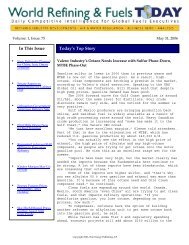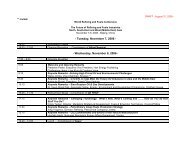ASTM: Gasoline Today and Tomorrow – An Executive Report
ASTM: Gasoline Today and Tomorrow – An Executive Report
ASTM: Gasoline Today and Tomorrow – An Executive Report
You also want an ePaper? Increase the reach of your titles
YUMPU automatically turns print PDFs into web optimized ePapers that Google loves.
Octane Week | <strong>ASTM</strong>: <strong>Gasoline</strong> <strong>Today</strong> <strong>and</strong> <strong>Tomorrow</strong> - <strong>An</strong> <strong>Executive</strong> <strong>Report</strong><br />
Fuel Ethanol Sulfate Specification Advances<br />
Despite Lacking Test Method<br />
This story appeared in July 2006.<br />
Members of <strong>ASTM</strong>ʼs gasoline subcommittee<br />
voted to add a 4 ppm sulfate limit to D4806, <strong>ASTM</strong>ʼs<br />
denatured fuel ethanol specification. The vote signaled<br />
acceptance by the ethanol industry, which had wavered<br />
in its support of a sulfate specification at any level.<br />
The vote is notable for another reason <strong>–</strong> it advances<br />
a specification that currently lacks an approved test<br />
method.<br />
A round robin on three sulfate detection test<br />
methods was conducted this spring but failed because<br />
of sample-related problems, <strong>and</strong> will be repeated this<br />
summer.<br />
The addition of a specification without an approved<br />
test method is unusual, but nothing has been usual in the<br />
effort to get a sulfate restriction into the ethanol st<strong>and</strong>ard.<br />
Since the beginning of the debate 18 months ago, oil<br />
<strong>and</strong> ethanol company representatives have hammered<br />
away at the issue, often with opposite goals.<br />
After resolving disputes over the need for a<br />
specification, the level <strong>and</strong> the placement <strong>–</strong> in the<br />
ethanol or the gasoline specification <strong>–</strong> one big issue<br />
remains unsettled <strong>–</strong> the test method.<br />
<strong>ASTM</strong>ʼs D02.03 Subcommittee on Elemental<br />
<strong>An</strong>alysis conducted an inter laboratory study (ILS)<br />
of a lead potentiometric titration method <strong>and</strong> two ion<br />
chromatography (IC) procedures in support of the<br />
ethanol sulfate specification. Unfortunately, the sulfate<br />
results were disappointing due to problems with the<br />
samples used in the round robin. The IC methods are<br />
also capable of detecting chlorides, which are a concern<br />
to ethanol producers, <strong>and</strong> the chloride data were<br />
excellent.<br />
“The sulfate data were not usable by any method,”<br />
said a member of the D02.03 subcommittee which<br />
organized the round robin. “The methods are robust.<br />
Round robin sample stability was the problem.”<br />
The ILS utilized 16 samples, all were prepared<br />
in denatured ethanol with varying amounts of sodium<br />
sulfate <strong>and</strong> sodium chloride dissolved in water. Samples<br />
varied between 0 <strong>–</strong> 20 mg/kg total sulfate <strong>and</strong> 0 <strong>–</strong> 50<br />
mg/kg total chloride. Unfortunately, the added sodium<br />
sulfate precipitated out of the samples during the duration<br />
of the round robin, rendering their results useless, while<br />
the sodium chloride remained in solution.<br />
“Concentrations of sulfates may change over<br />
time,” explained a D02.A member. “Through an<br />
oxidation reduction process, sulfates can change to<br />
sulfites or sulfides, which may not be detected by the<br />
test methods.”<br />
A second round robin will be conducted, <strong>and</strong> it<br />
will include an oxidation step in the IC methods to<br />
stabilize the sulfate in the ethanol samples. Hydrogen<br />
peroxide will be added to samples, which will convert<br />
other species to sulfate prior to testing, providing a<br />
measurement of “potential sulfate.”<br />
The procedure not adding the hydrogen peroxide<br />
will be retained for a total sulfate measurement. Because<br />
hydrogen peroxide will damage the lead sensor used in<br />
the lead titration method, the oxidation step will not be<br />
used in samples tested by the titration method.<br />
Despite the failure of the first ILS to yield useful<br />
sulfate precision data, DO2.A voted to accept a 4 ppm<br />
sulfate limit in D4806, with the underst<strong>and</strong>ing that a<br />
second round robin will be conducted <strong>and</strong> will likely<br />
produce useful data.<br />
The same labs agreed to participate in the second<br />
round robin, which could start as soon as next month. If<br />
the data are returned in time, the three methods will be<br />
balloted for approval with full precision statements in<br />
D02 at the December meeting.<br />
February 2007 13
















